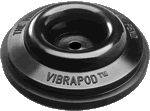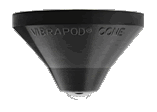  The Vibrapod Company623 Hanley Industrial Court |
Phonogram
is a discussion group for those who listen to, collect, or otherwise enjoy
music on records. The group is an open, informative, interesting, and
just plain fun place for people to share their enthusiasm for, knowledge
of, and opinions on music on shiny black discs.The
Phonogram List can be joined by sending an E-mail to: with the command "subscribe" in the message body, without the quotes. Those who of you who pay attention to my posts from the past might remember that I have the BrightStar Ultimate TNT base (a combination of the AirMass and the Big Rock for TNT). The addition of the TNT's flywheel of late has caused me to pretty much take everything down and re-think my turntable isolation strategy. It seems that there's a few people on the list with TNT Jrs as well, so I figured I'd post to the list, with my experiences. A re-arranging of my listening room prompt about a month ago forced a tear-down of the TNT and the BS system -- the sandbox had to be unfilled, etc., and I just didn't have the will to refill it after moving the turntable to its new spot -- 90lbs of sand is a royal pain in the ass. So, just for kicks, I listened to the table with just the [inflated] AirMass. It wasn't bad, but the bass was a little flabby and not as tight as with the sandbox. I can't emphasize the importance of physically damping and isolation of the TNT's stand-alone motor assembly (SAMA) -- attaching (with a 2" square Neoprene pad, but BluTak should work as well) a Black Diamond Racing 'Thing' to the bottom of the SAMA so that its feet don't touch the shelf lowered the noise floor and tightened up the bass. Neat -- you should try this sometime, if you have a turntable with an SAM. A couple of experiments ensued -- I tried 1 3/4" thick maple butcher blocks (from Ikea, no less), BDR 'Shelves' (as in TWO of them), and finally a combination of the BDR and Vibrapods. (The latter as a combination because I didn't have any big 32" x 20" MDF boards around) It truly is fascinating to hear the differences in performance across all the variations in composition -- anyone who says that a turntable support isn't important should have their head examined. By now you'll probably clue into the fact the best performance was derived by the last combination of BDR Shelves and Vibrapods (24 in total!) (...if it wasn't, I would have kept experimenting). The final configuration looked something like this (apologies for the ASCII graphics): BDR Shelf BDR Shelf Graphics to be added later. [top view, 'pods underneath the BDR Shelves] (where FW == flywheel, S == spindle of platter, P == pulley foot, O == TNT foot, and {1,2,3} == Vibrapod model#) I'm still think that there MUST be a better way to set the Vibrapods up (by using higher number model 'pods, and by using less 'pods in general), but I was just using what I had handy (RSF seems to be hoarding his) in order to support the 100lbs of the behemoth known as the TNT. Enough already, what do these suckers do for the table? I noticed a couple things right away, namely: - better separation of instruments and voices; I perceived this as less congestion or 'overlap' of instruments -- maybe this is just better layering as per the next claim - a more distinct boundary between the above -- for example, the physical separation of the first violin and second violin sections in an orchestra is much better defined - a tightening of the bass, giving without a doubt the impression of "bass foundation" (or for the musically inclined, pedal points) - again, a lower noise floor -- instruments eerily just 'hover' in space, and small details (like hall decay, the rate of a soloists' vibrato, how musicians finish their phrases, the ring of vibraphones, etc.) are pulled from the groove A couple of other interesting things happened, which require more than a quick note: a) pre-Vibrapod I've always noticed that there was a 'sameness' in the presentation of instruments panned hard left or right in the speakers; now, instead instruments may come from slightly left, right or behind the speakers depending on the recording b) small changes in VTA are CLEARLY audible now -- the separation and 'air' (arrgggh, I've reverted to reviewerspeak again) between instruments tends to collapse when the VTA is mis-adjusted. (Before adjustments in VTA clearly altered the *tonality* of instruments, particularly in the bass department) c) I can now verify (and concur) with the manufacturer's claims that the 'pods don't work too well in conjunction with (passive) pneumatic suspensions -- while all of my 'claims' above are exhibited with the AirMass inflated, they IMO they are even greater differences with the AirMass deflated. Same results with my tube amp (which is resting over a air-filled camping pad). Not sure what voodoo is happening there... d) I've noticed that some late number EMI ASD's which I thought had mildly steely string tone, seem to have improved somewhat -- a little lusher than before (eg: the later Boult reading of Holst's Planets, and for no particular reason seems to be in my pet stack of records of late) e) while I hate to open this seemingly bottomless can of worms, Classic reissues (even those cut with tube amplifiers) now sound like there's something being sucked out of the midrange; my impression is that this is related to the lack of congestion -- could just be that I haven't spent enough time finding the right VTA settings for these records, though OK, time to wrap things up. One of the benchmarks I use for measuring improvements in the system is to compare it (on a musical enjoyment scale) to a system like Richard Fosters' (one of the perks living in the Toronto area). Not meaning to knock Richard Foster, but with the addition of the 'pods (plus the VPI flywheel, pulley system, and the Walker turntable power supply), my system is finally starting to approach the performance of his, and I'm *not* kidding. (I betcha he's laughing or rolling his eyes right now... or at least I hope he is, HAH!) Right now, the recreation of performances of large-scale orchestral work is simply breathtaking -- it's a blast. Next time: my experiences with the flywheel addition and the pulley system to the TNT Jr., maybe even a mini-review of the Nadja Salerno-Sonneberg performance of the Tchaikowsky Violin Concerto with the Toronto Symphony... (can you tell who's on a mini-vacation for the next week?) - John |

